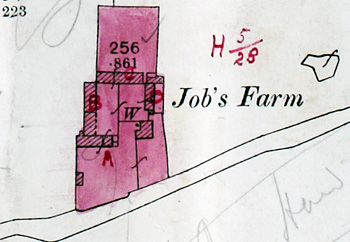Jobs Farm Woburn

Job's Farm on the map accompanying the 1926 valuation
Job’s Farmhouse is largely hidden from view along the road to Little Brickhill [Buckinghamshire]. The farmhouse was listed by the former Ministry of Works in January 1961 as Grade II, of special interest. It dates from the early 18th century and is timber-framed with colourwashed brick infill; the property has a thatched roof. It is built in an L-shape and comprises one storey with attics. The brick porch is 20th century.
In 1887 an inventory and valuation of crops was carried out on a change of tenancy from Frederick Whitlock to Thomas Tompkins [SF75/16]. Kelly’s Directory for the county was not published every year but every few years. Those for 1898, 1903, 1906, 1910, 1914 and 1920 give the tenant of the farm as Frank Tompkins, who also held Church Farm in 1914.
During the First World War German U-Boats posed as great a threat to British shipping as in Word War Two. By 1917 the situation was so serious that there were real concerns that the country might be forced to make terms due to shortages of food and other necessities. War Agricultural Executive Committees run by county councils were ordered to find ancient grassland which could be ploughed up to sow arable crops. Such orders were usually not well received by the farmers in question as it was felt that the crops yielded would make small profit and might fail altogether. Frank Tompkins was ordered to plough up some of the grassland at Job’s Farm and made a formal objection [WW1/AC/OP1/1]. Fortunately the introduction of the convoy system meant that the U-Boat menace was brought under control and the food shortages eased regardless of whether additional land was brought under the plough
The Rating and Valuation Act 1925 specified that every building and piece of land in the country was to be assessed to determine its rateable value. Job’s Farm was visited and assessed in 1926 [DV1/H5/28] and the valuer found it owned, like most of the parish, by the Duke of Bedford’s London and Devon Estates Company. The farm was now in hand and worked by the estate without a tenant.
The farm comprised 128 acres and the valuer, visiting on 7th August 1926 at 2 p.m. noted: “Water – well. Lighting lamps. Sanitation Earth. Market Bedford 15 miles; Leighton Buzzard 7 miles. Woburn Sands Station 3½ miles. Foreman – Walter Battam. Saw Mrs. Battam. The farm is actually managed by H. A. Peto (of Birchmoor Farm) who is the Duke of Bedford’s manager”. Another hand wrote on 5th November 1926: “A Poor Farm”.
The farmhouse comprised a bedroom, a living room, a kitchen, a pantry and an earthy closet downstairs. The valuer commented: “This cottage is now on one floor only: the upper floor was recently demolished and the ceilings of the ground floor were raised. The very limited residential accommodation appears to be a distinct drawback to what otherwise is a very compact little farm”. The homestead was divided into four blocks as below:
- A: brick and slate four bay open cowshed, fowl house and two pigsties;
- B: brick and slate four bay open cowshed, mixing house and cowhouse for four;
- C: a weather-boarded and slated barn;
- D: brick and slate loosebox, carthorse stable for four and a two bay open cowshed.
“Water laid on”.